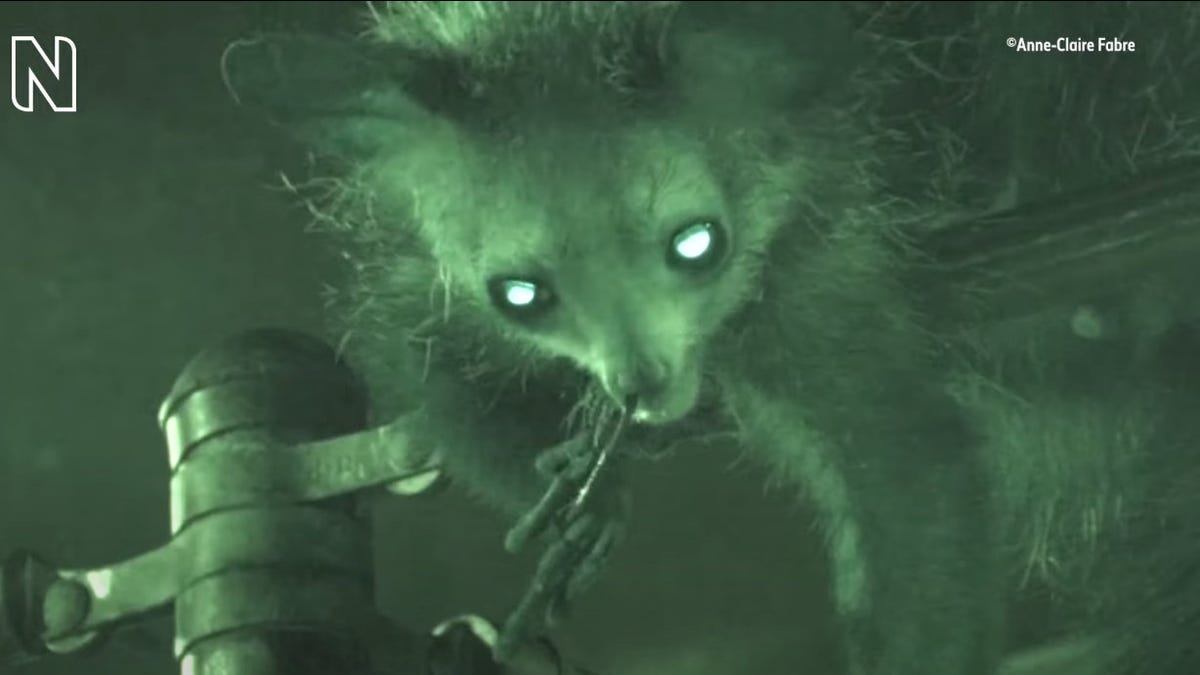This Nose-Picking Lemur Deserves Its Own Horror Movie
A rare aye-aye lemur picks its nose on camera, and scientists are blown away.
One thing I didn't expect to do this week was laugh my head off at a video of a lemur picking its nose. But here we are. Even if you're grossed out, it's worth sticking around to learn why scientists were so shocked over the lemur's nose-picking prowess.
An aye-aye (an endangered lemur that lives in Madagascar) is the star of a new study published this week in the Journal of Zoology titled "A review of nose picking in primates with new evidence of its occurrence in Daubentonia madagascariensis." Daubentonia madagascariensis is the scientific name for aye-ayes.
The research team says a video of a captive aye-aye named Kali at the Duke Lemur Center in North Carolina represents the first time an aye-aye has been recorded picking its nose and eating the snot. Lead study author Anne-Claire Fabre, a biologist with the University of Bern, captured the footage, which you really must see to believe.
Here's the recap: Kali sticks her 3-inch-long (8 centimeter) third finger into her nasal cavity. The finger pretty much disappears before she pulls it back out and cleans it off with her mouth. Aye-ayes have six digits on each hand.
Fabre called the nose-picking "impressive" in a statement from the Natural History Museum in the UK on Thursday.
Aye-ayes typically use that long middle finger to dig out food from trees, but it seems to work quite well for digging into the depths of its own head. The nose-picking evidence adds aye-ayes to an exclusive list of about a dozen primates that pick their noses, including humans, chimpanzees and gorillas.
Study co-author Roberto Portela Miguez was surprised by the initial video, but there was more to come. "We were in for an even bigger surprise when we used CT scanning to see how the nose picking works internally, and the scan was mind-blowing. We were shocked from the reconstruction that the aye-aye's finger could reach through its nose almost to the back of its throat," he said
Now you've had time to process the video, check out this graphic showing what the CT scan revealed. The green extension represents the aye-aye's finger.
This look inside an aye-aye's head shows just how far its long middle finger can reach while picking its nose.
There's some nifty science vocabulary to go along with this. "Rhinotillexis" refer to nose-picking and "mucophagy" is the act of ingesting it. The team is interested in hearing from researchers to see if they've observed nose-picking activities in the wild, or if the aye-aye's nasal excavation might be related to being in captivity.
This is more than a "wow, look at that crazy thing" moment. The researchers are investigating not only which species pick their noses, but why they do it, a topic that hasn't been studied much. The behavior is seen in animals with a lot of dexterity, though it's possible it may not be limited to primates.
The "why" of it all is a little hazier. The paper says rhinotillexis "remains poorly understood and only a few scientific studies have attempted to elucidate the origin and potential relevance of this behavior." Possible reasons may be to relieve discomfort from dried mucus or to gain a little bit of hydration through a quick nibble.
The science team hopes its review of nose-picking evidence in primates will kick off more research into the overlooked topic and also bring attention to aye-ayes, which are threatened by habitat loss and hunting. The study also shows that profound science inspiration can come from unlikely places -- like a snot-licking lemur.


